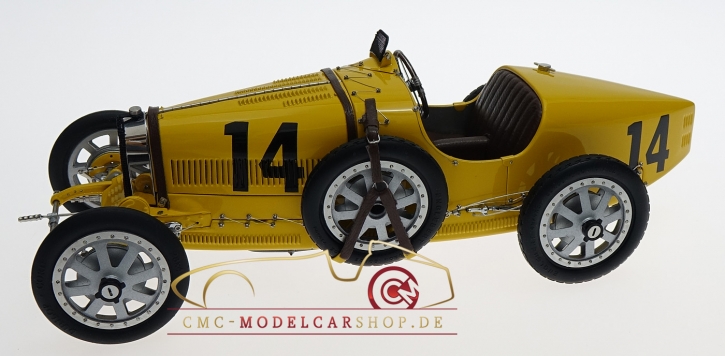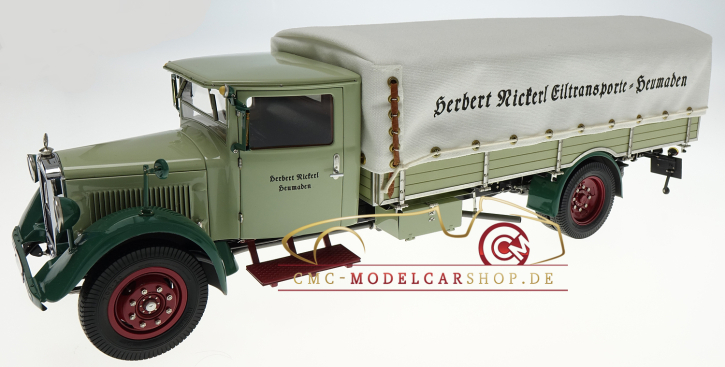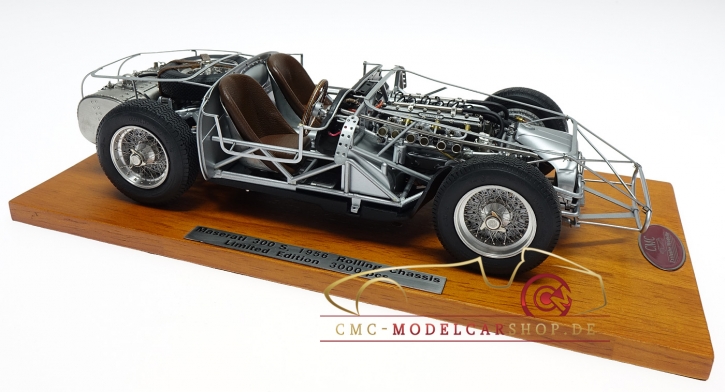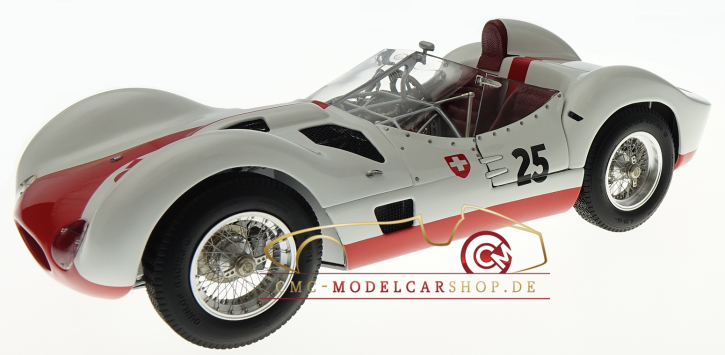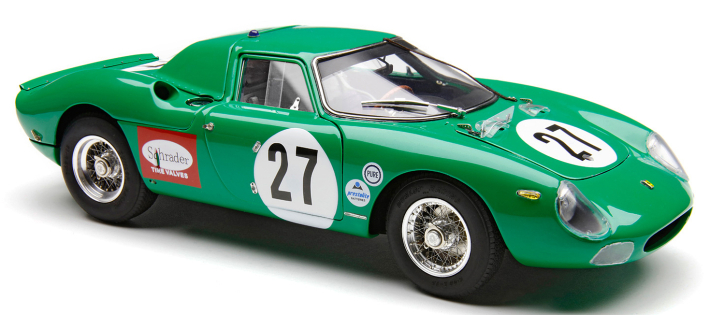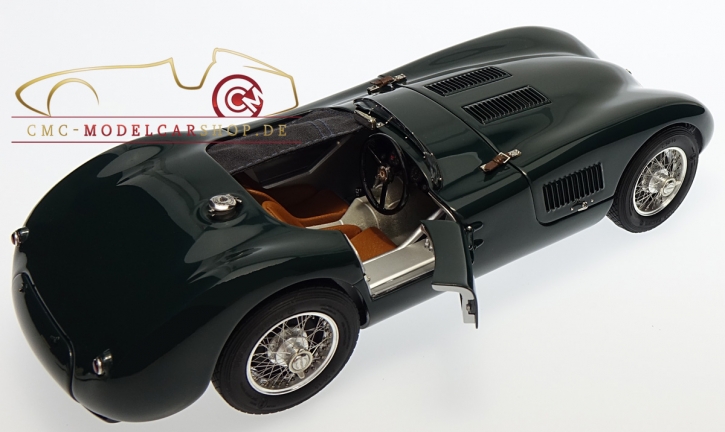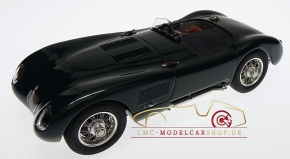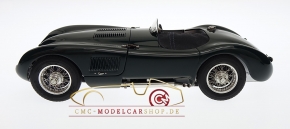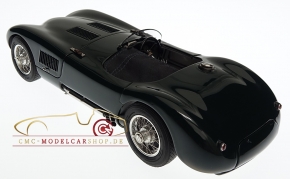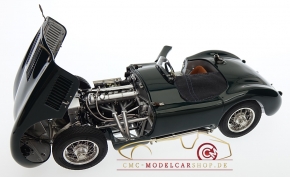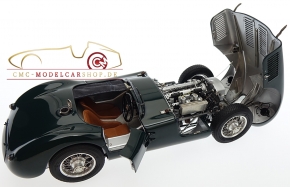product description
CMC will launch a standard edition of the Jaguar C-Type in the classic British Racing Green.
- Model: Precision model hand-assembled
- Manufacturer: CMC GmbH, Classic Model Cars, Germany
- Scale: 1:18
- Item-No.: M-191
- Color: British Racing Green
- Limited Edition: not limited
- Metal precision model hand-built from 1,155 parts
- Flip-open and lockable engine hood
- Realistic replica of the straight six engine complete with encircling components, pipes and cabling
- Metal exhaust pipes
- Triangular front axle with wishbones, hydraulic shock absorbers, longitudinal
- torsion bar suspension, all made of metal
- Rigid rear axle with transverse torsion bar suspension, hydraulic shock absorbers, longitudinal links, all made of metal
- Radiator grille hand-made of stainless steel
- Detailed replication of the cooling system
- Detailed fuel and oil circulation
- Authentically-replicated hinged fuel cap
- Driver´s door openable on realistic-looking hinges
- Upholstered leather-covered driver and passenger seats
- Perfectly crafted wheels with stainless-steel spokes and nipples on alloy rims
- Screw-on central locking nuts with right-/left-handed threads
- Elegant and brilliant finish in original British Racing Green
One would like to know what was going on in the minds of Heynes and Lyons, the two Jaguar executives, who decided in the late summer of 1950 to take part in a race that would be held only a few months later at Le Mans. When the factory team arrived on the Sarthe in 1951 for training, the cars were unpro-ven. Were Heynes and Lyons really looking for a chance to win? The anwer came in the form of subsequent victories of the C-Type at the Sarthe 1951 and 1953.
At the London Motor Show in 1948, Jaguar introduced its brand new XK 120 as a limited production model for use in motorsport. Fascinated by the XK120 form and its technology, the crowd surprised the Jaguar managers with significantly higher demand. Lyons decided to continue to develop the XK120 as a production vehicle and to offer it worldwide. In North Americ, the sale of the vehicle had overwhelming success. With its very close-to-introduction XK120 achieving an extraordinarily honorable success at 1950 Le Mans, William Lyons and Bill Heynes soon agreed to get the big shell in the following year with a Jaguar.
Developed with goal Le Mans The long-distance classic was the main target for Jaguar, and its management was aware of the marketing effect of a success in Le Mans. Accordingly, Jaguar put emphasis on high reliability, good handling characteristics, and aerodynamic balance of speeds. Chief engineer Bill Heynes did a great job. The engine of the XK 120 was upgraded with larger SU carburetors to 210 hp. The chassis was redeveloped as a tubular frame. In addition Jaguar introduced a lightweight aluminum body with only one door for the driver. The design was a contribution by Malcolm Sayer, a gifted engineer who had years of experience designing for the English RAF aircraft.
The cockpit was protected only by a small racing disc. Also, the space in it was rather than narrow. But Jaguar drivers like Moss, Walker or Whitehead found in the cockpit of the C-Type all the necessary in-struments and even spare spark plugs and tools for repairs during the race event.
The appearance of Jaguar at the Sarthe 1952 failed, and all three vehicles were eliminated by overheating of the engines. It was rumored that Stirling Moss thought the new Mercedes SL were stronger than they actually were in the race. The failure of the Jaguar fleet made the Mercedes victory no less valuable, but a little easier. The next attempt came in 1953. The Jaguar team was equipped with more powerful engines, three Weber carburetors and Dunlop disc brakes in the improved C-type. It was followed by game, set and victory. Among the first ten vehicles that flew past the panned flag on June 27, 1953 were four C-Type: 1st, 2nd, 4th and 9th. William Lyons dedicated this triumphal march to Queen Elizabeth, who had just been enthroned. Her Majesty returned the favor in her own way and knighted the Jaguar chief in the spring of 1956.
The use of racing team and/or driver names, symbols, starting numbers, and/or descriptions is solely for reference purposes. Unless otherwise stated, it does not imply that the CMC scale model is a product of any of these racing teams/drivers or endorsed by any of them.
- Sports car built on a tubular frame
- Body shell made of extra thin alloy sheet metal
- 3.4-litre 6-cylinder in-line-engine
- Two valves per cylinder controlled by two overhead camshafts
- Dry sump oil lubrication
- Mixture preparation with two SU 2”-carburettors type H8/9
- Coil/ capacitor ignition, one plug per cylinder
- Four-speed manual gearbox mounted to the engine
- Maximum output: 200 HP at 5,800 rpm
- Displacement: 3,442 cc
- Bore x Stroke: 83 x 106 mm
- Top speed: 230 Km/h (depending on ratio)
- Wheelbase: 2,438 mm
- Total length: 3,988 mm
- Total width: 1,638 mm
- Track front/rear: 1,295 / 1,295 mm
- Total height: 1,081 mm
- Curb weight: 970 kg (2102 lb.)
Product safety - Manufacturer information (GPSR)
CMC GmbH & Co. KG, Stuttgarter Str. 106, 70736 Fellbach
Contact: www.cmc-modelcars.de
Sicherheitshinweis / Consigne sécurité / Safety warning:
Sammlermodell - Nicht für Kinder unter 14 Jahren geeignet
Modèle de collection - Ne convient pas aux enfants de moins de 14 ans.
Collector's model - Not suitable for children under 14 years of age
Review(s)
Wrote by Jean-Paul S. on 07.10.2020
Parfait
Attention à l'ouverture du coffre de la roue de secours. Danger de perdre la vis minuscule. Impossible à retrouver...
Wrote by Anders T. on 15.09.2020
Very nice model
Super quality.
Wrote by Dominique G. on 19.02.2019
Excellent
Bravo! A quand une Jaguar Type E?












